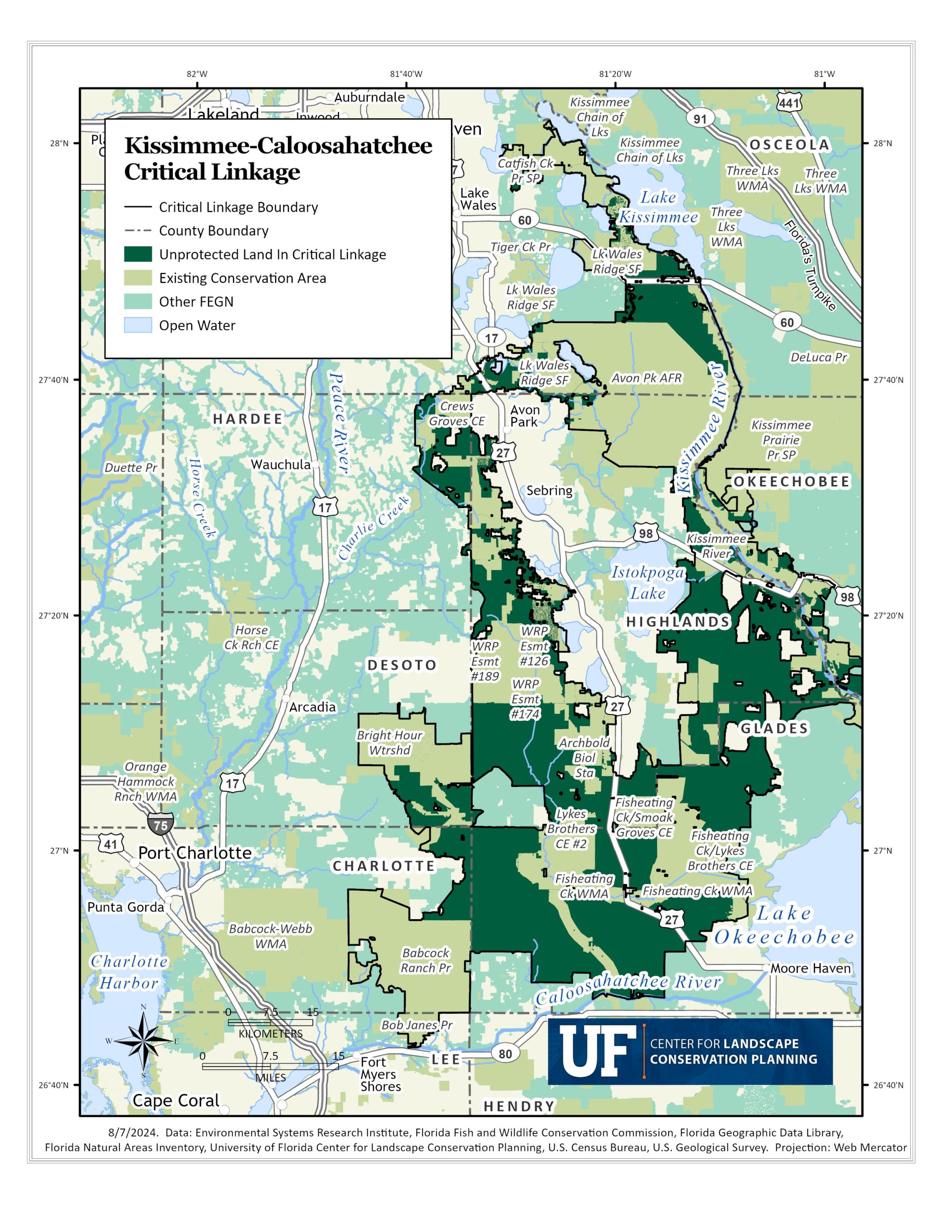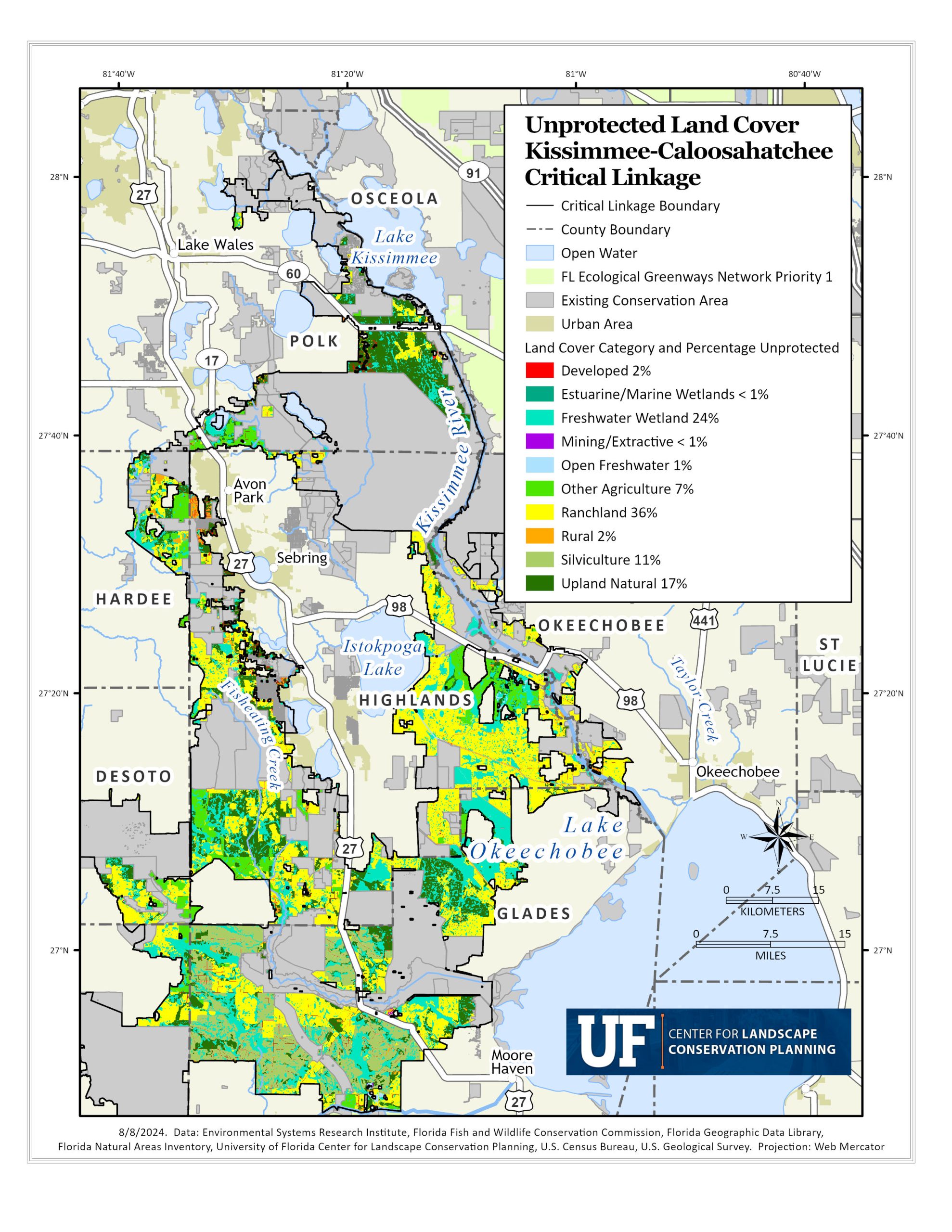The Kissimmee-Caloosahatchee Critical Linkage
North of the Caloosahatchee River, a central connection for the FEGN and Florida Wildlife Corridor expands from the Babcock Ranch Preserve to Avon Park Airforce Range and Kissimmee Prairie. This is one of Florida’s great sentinel landscapes; where conservation areas, working lands, and national defense interests converge and collaborate to further conservation and military goals.

The Kissimmee-Caloosahatchee linkage in its complete state would protect riparian corridors and their upland landscape west of Lake Okeechobee that plays an essential role as the headwaters of the Everglades, connect the Florida Panther’s range northward and preserving Florida’s native prairie region. The linkage also supports the heart of the Southwest Florida ranchland, preserving a way of life intertwined with conservation goals for the state of Florida, like the preservation of Florida’s Great Prairie Region. With models showing a slow loss of habitat due to sea level rise in the current occupied breeding range for the Florida Panther, this linkage is especially important for a viable future panther population that will move to future dry land inland and northward within the Caloosahatchee – Kissimmee region.
The linkage follows two main river corridors: a western route encapsulating Fisheating Creek, and an eastern route that follows the Kissimmee River. The tannin-colored blackwaters of Fisheating Creek meander through swamps, marshes, forested wetlands and floodplain marsh, eventually making their way south slowly as the last naturally flowing tributary to Lake Okeechobee. The banks of Fisheating Creek ebbs and flows with Florida’s seasons; in winter dry months, the cypress lined swamps surrounding the creek dry up, acting as passageways for terrestrial animals like the Florida Panther and Black Bear. The creek is a unique recreation, hunting and fishing destination for those who desire secluded excursions through pristine central Florida terrain or winding waterways.
East of Fisheating Creek, the Kissimmee River originates just south of the Orlando metro area from East Lake Tohopekaliga before flowing south into the north shore of Lake Okeechobee. In contrast to Fisheating Creek, the Kissimmee River was heavily altered by humans from the 1950s – 1970s due to concerns over flooding threats to human habitation in the area. 103 meandering miles of river were channelized, widened and deepened to a new length of 56 miles, surrounding wetlands were drained and converted to agriculture or residential development, and locks and dams were installed to control water flow along the river-turned-canal. This resulted in an alarming decline of the ecological integrity of the Kissimmee River Basin ecosystem, Lake Okeechobee and ultimately the Everglades that depend on this riparian system. The ecological crises that resulted from the conversion of the Kissimmee River to the C-38 Canal turned the story into the “Canary in the Coal Mine” for water quality concerns in the central-south Florida region. The Kissimmee River Restoration Project, which began in the early 1990s, has been one of the most successful, and largest, examples of ecosystem restoration in the world. With it’s completion, almost 25,000 acres of wetland and over 45 miles of meandering river have been restored. Land protection in Caloosahatchee-Kissimmee Critical Linkage would further protect and enhance the efforts of this monumental restoration project.
Both Fisheating Creek and the Kissimmee River support vital ecological processes that serve as the foundations for ecosystem services that many Floridians in central and south Florida depend on. The restoration of the Kissimmee River proved the importance of investing in the preservation of natural resources, not only for the integrity of habitat but for the benefits to humans they provide, such as aquifer recharge, natural flood management, improved water quality, recreation and more. The water purification that takes place along the waterways affects the quality of water that ultimately flows from Lake Okeechobee, through the Everglades, ultimately into the Florida Bay surrounding the Florida Keys. Other important waterbodies within the linkage include the Everglades and Caloosahatchee watersheds, as well as some of the Peace River Basin. All these riverine systems are critical waterways for the Everglades.
Upland from the rivers, the Caloosahatchee-Kissimmee Linkage expands into the heart of Florida ranch territory. Although not identical to the virgin prairie that once blanketed the region, the ranch mosaic is an open, prairie-like system where many focal species (like the Crested Caracara, Florida Grasshopper Sparrow, and Florida Burrowing Owl) are present and thrive. The typical large ranges of ranchland not only offer a variety of habitats, but offer that habitat in an unfragmented condition, which is an essential component of successful regional corridors. Their intact wetlands, floodplains and large expanses of permeable ground provide significant ecosystem services, maintaining water quality, managing floodwaters, and allow for aquifer recharge. Preserving ranch operations in the linkage is not only important for conservation goals, but for the protection of Florida’s rural economy and way of life. Florida has the longest history of ranching out of all states in the country, and this heartland of Florida was where ranching in the state was first practiced. Today, many of the ranches within the Caloosahatchee-Kissimmee region are multigenerational operatives that continue to foster this unique Floridian history and culture.

Unprotected Land Cover Map for the Kissimmee-Caloosahatchee Linkage
The future of the linkage is dependent on the protection of currently unprotected land within this FEGN / Florida Wildlife Corridor priority one region. This map provides a breakdown of the types of unprotected land cover in the Kissimmee-Caloosahatchee linkage.

